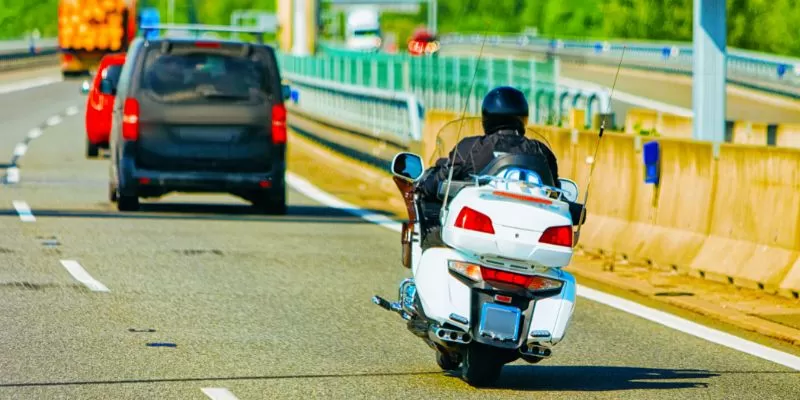
Understanding Lane Splitting in California
Motorcyclists may split a lane of traffic to move past slower-moving vehicles. However, state law may not place any strict limits in terms of speed, but it is recommended that motorcyclists avoid splitting lanes by moving faster than 10 mph more than the drivers around them or when surrounding traffic is moving faster than 30 mph. Most of the highways in the state have speed limits well over 30 mph, so any motorcyclist who intends to split a lane on the highway must use extreme caution when doing so.
Lane-splitting is often conflated with lane-sharing, which defines two vehicles sharing space in the same lane of traffic. This is legal for motorcyclists in the state and, in some cases, can help them stay safer on the road, especially at night. For example, two motorcyclists riding side-by-side at night in the same lane will appear as a standard passenger vehicle from behind, so they will be more obvious to other motorists.
If a motorcyclist intends to split a lane, they must do so very carefully and only when it appears as safe as possible to complete the maneuver. It’s generally wisest for motorcyclists to never attempt splitting a lane around a curve or turn. If you must split a lane, wait until the road straightens, and you can more easily assess the speeds of the drivers you intend to pass. Lane splitting at an inopportune time can startle others or cause the motorcyclist to lose control of their vehicle. While splitting a lane may seem like a basic concept, this is, in practice, an advanced maneuver that only experienced riders should attempt.
What to Do After a Motorcycle Accident in California
Motorcycle accidents are less common than car accidents in the state simply due to the fact that there are fewer motorcycles than passenger cars on state roads. The reality is that motorcyclists face the same risk factors as all other drivers, but their bikes provide none of the safety features found in most enclosed passenger vehicles. This means the motorcyclist has no airbag, seatbelts, or a crash-resistant frame to absorb impact. When motorcycle accidents happen, there is a much greater chance for catastrophic or fatal injury than there would be in a standard passenger vehicle accident.
When a motorcycle accident happens, the injured victim needs to determine fault for the incident before they can claim compensation for their damages. State law requires every driver and every motorcyclist to have auto insurance that includes liability coverage for bodily injury and property damage, and filing an insurance claim is typically the first step toward recovering from any vehicle accident. If that lane splitting causes an accident, it is possible for all drivers involved to share fault for the incident, and accurately determining liability can be incredibly challenging.
FAQs About California Motorcycle Lane Splitting Laws
Is Lane Splitting Legal in CA?
Yes, but only for motorcyclists. A motorcyclist may split the lane to pass between slower-moving lanes of traffic and to escape a potential rear-end collision. Two motorcyclists may also share the same lane side-by-side, which can help them be more visible to other drivers in some situations, especially when driving at night.
How Fast Can You Lane Split?
To successfully lane split, a motorcyclist will likely need to move faster than adjacent lanes of slower-moving traffic. State lawmakers recommend going no more than 10 mph faster than the vehicles on either side. Additionally, it is recommended that motorcyclists avoid splitting lanes in traffic moving faster than 30 mph.
Can You Lane Split on the Highway?
Technically, it is legal to lane split on the highway in the state. However, this should only be done when necessary and with extreme caution. While there is no law that prevents motorcyclists from lane splitting, it is recommended that drivers avoid the practice in traffic moving faster than 30 mph. This would include most highway traffic.
Why Does the State Allow Lane Splitting?
Many decry lane splitting as reckless, but lawmakers have acknowledged the arguments of proponents of the practice, citing the fact that lane splitting can not only enable a smoother flow of traffic in some areas but also help keep motorcyclists safer. Lane splitting can allow a motorcyclist to avoid an impact from a driver coming behind them. Lane splitting is also believed to alleviate traffic congestion, which is notoriously high throughout the metropolitan areas.
What Happens if a Lane-Split Leads to an Accident?
The state uses the fault rule to resolve vehicle accident cases, so it is vital to prove fault for any accident before any compensation can be recovered. If you are involved in a lane-splitting accident, it is essential to seek out legal counsel you can trust. An experienced attorney can help you prove fault for the incident and hold the at-fault driver appropriately accountable for the harm they’ve caused.
Ultimately, lane splitting is legal in California but must be done safely. When accidents happen from negligent lane splitting or any other causes, victims need to know their rights in terms of collecting compensation for their damages and how to ensure accountability. Easton & Easton can provide the legal counsel you need after a motorcycle accident or any other vehicle accident, so contact us today and schedule a consultation with our team to learn more about the services we provide.

